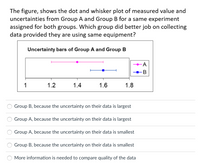
College Physics
11th Edition
ISBN: 9781305952300
Author: Raymond A. Serway, Chris Vuille
Publisher: Cengage Learning
expand_more
expand_more
format_list_bulleted
Question

Transcribed Image Text:The figure, shows the dot and whisker plot of measured value and
uncertainties from Group A and Group B for a same experiment
assigned for both groups. Which group did better job on collecting
data provided they are using same equipment?
Uncertainty bars of Group A and Group B
1
1.2
1.4
1.6
1.8
Group B, because the uncertainty on their data is largest
Group A, because the uncertainty on their data is largest
Group A, because the uncertainty on their data is smallest
Group B, because the uncertainty on their data is smallest
More information is needed to compare quality of the data
Expert Solution
This question has been solved!
Explore an expertly crafted, step-by-step solution for a thorough understanding of key concepts.
This is a popular solution
Trending nowThis is a popular solution!
Step by stepSolved in 2 steps with 2 images

Knowledge Booster
Learn more about
Need a deep-dive on the concept behind this application? Look no further. Learn more about this topic, physics and related others by exploring similar questions and additional content below.Similar questions
- The same projectile experiment was conducted as you did in class. A racquet ball rolls down a track, leaves the track at an initial height of 0.961m above floor, with an exit speed Vexit 1.40m/s at an angle exit 7.46°. The landing spot was repeatedly measured for ten times, and the racquet ball's horizontal range data is provided below. Data run = Landing spot (m) 1 2 0.585 0.590 3 4 0.595 0.590 5 6 0.585 0.580 7 0.580 8 = 9 10 0.585 0.580 0.575arrow_forwardReport your answer to two decimal placesarrow_forwardMeasured values are usually presented as mean plus or minus uncertainty. If two experimental valuesare (8.1 ± 0.5) and (7.9 ± 0.4), what is the uncertainty of their difference?arrow_forward
- Let A = 2 x2y3Where x= 16 ± 0.5 and y = 9 ± 0.3Please find the nominal value of A and the uncertainty in this term.arrow_forwardFind the uncertainty in the moment of interia. Moment of interia of a disk depends on mass and radius accordng to this function I(m,r) = 1/2 m r. Your measured mass and radius have the following uncertainties Sm = 0.34 kg and Sr = 0.17 m. What is is the uncertainty in moment of interia, %3D S1 , if the measured mass, m 6.05 kg and the measured radius, r = 14.74 m? Units are not neededarrow_forwardCan you please explain how to solve the uncertainty for this problem. I previously asked the same question but the answer for the uncertainty i was given is wrong +/- 0.00559arrow_forward
- A marathon runner completes a 42.188-km course in 2 h, 35 min, and 39 s. There is an uncertainty of 28 m in the distance traveled and an uncertainty of 1 s in the elapsed time. (Give all answers to the appropriate number of significant figures. Note that uncertainties should be reported to one significant figure and percent uncertainties should be reported to two significant figures.) (a) Calculate the percent uncertainty in the distance. _________% (b) Calculate the percent uncertainty in the elapsed time. __________%arrow_forwardFor questions (1) – (8) use the following information. You have measured the length of a table to be 205.0 cm, 205.8 cm, 205.4 cm, 204.6 cm, and 204.9 cm five independent times. You measured the width of the same table to be 60.1 cm, 60.4 cm, 60.2 cm, 60.0 cm, and 60.5 cm five independent times. 1) Calculate the mean length L of the table. 2) Calculate the standard deviation of the mean length σ of the table. 3) Calculate the mean width W of the table. 4) Calculate the standard deviation of the mean width ow of the table. 5) Calculate the area A = L x W of the table. 6) Using the correct equation for propagation of error, calculate the uncertainty of the area OA of the table.arrow_forward
arrow_back_ios
arrow_forward_ios
Recommended textbooks for you
 College PhysicsPhysicsISBN:9781305952300Author:Raymond A. Serway, Chris VuillePublisher:Cengage Learning
College PhysicsPhysicsISBN:9781305952300Author:Raymond A. Serway, Chris VuillePublisher:Cengage Learning University Physics (14th Edition)PhysicsISBN:9780133969290Author:Hugh D. Young, Roger A. FreedmanPublisher:PEARSON
University Physics (14th Edition)PhysicsISBN:9780133969290Author:Hugh D. Young, Roger A. FreedmanPublisher:PEARSON Introduction To Quantum MechanicsPhysicsISBN:9781107189638Author:Griffiths, David J., Schroeter, Darrell F.Publisher:Cambridge University Press
Introduction To Quantum MechanicsPhysicsISBN:9781107189638Author:Griffiths, David J., Schroeter, Darrell F.Publisher:Cambridge University Press Physics for Scientists and EngineersPhysicsISBN:9781337553278Author:Raymond A. Serway, John W. JewettPublisher:Cengage Learning
Physics for Scientists and EngineersPhysicsISBN:9781337553278Author:Raymond A. Serway, John W. JewettPublisher:Cengage Learning Lecture- Tutorials for Introductory AstronomyPhysicsISBN:9780321820464Author:Edward E. Prather, Tim P. Slater, Jeff P. Adams, Gina BrissendenPublisher:Addison-Wesley
Lecture- Tutorials for Introductory AstronomyPhysicsISBN:9780321820464Author:Edward E. Prather, Tim P. Slater, Jeff P. Adams, Gina BrissendenPublisher:Addison-Wesley College Physics: A Strategic Approach (4th Editio...PhysicsISBN:9780134609034Author:Randall D. Knight (Professor Emeritus), Brian Jones, Stuart FieldPublisher:PEARSON
College Physics: A Strategic Approach (4th Editio...PhysicsISBN:9780134609034Author:Randall D. Knight (Professor Emeritus), Brian Jones, Stuart FieldPublisher:PEARSON

College Physics
Physics
ISBN:9781305952300
Author:Raymond A. Serway, Chris Vuille
Publisher:Cengage Learning

University Physics (14th Edition)
Physics
ISBN:9780133969290
Author:Hugh D. Young, Roger A. Freedman
Publisher:PEARSON

Introduction To Quantum Mechanics
Physics
ISBN:9781107189638
Author:Griffiths, David J., Schroeter, Darrell F.
Publisher:Cambridge University Press

Physics for Scientists and Engineers
Physics
ISBN:9781337553278
Author:Raymond A. Serway, John W. Jewett
Publisher:Cengage Learning

Lecture- Tutorials for Introductory Astronomy
Physics
ISBN:9780321820464
Author:Edward E. Prather, Tim P. Slater, Jeff P. Adams, Gina Brissenden
Publisher:Addison-Wesley

College Physics: A Strategic Approach (4th Editio...
Physics
ISBN:9780134609034
Author:Randall D. Knight (Professor Emeritus), Brian Jones, Stuart Field
Publisher:PEARSON